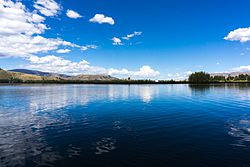Laguna de Paca
| Laguna de Paca | |
|---|---|
 |
|
| Location | Junín Region |
| Coordinates | 11°43′47″S 75°30′24″W / 11.72972°S 75.50667°WCoordinates: 11°43′47″S 75°30′24″W / 11.72972°S 75.50667°W |
| Basin countries | Peru |
| Surface area | 21.40 km2 (8.26 sq mi) |
| Surface elevation | 3,418 m (11,214 ft) |
Laguna de Paca, also known as Paca Lagoon, is a placid lake in Peru. It is located 4 kilometres (2.5 mi) north of the historic town of Jauja, which was once the capital of Peru, before Lima was built as its new capital. The lake precincts is habitat for rich flora and fauna. The lake is sourced to springs.
Laguna de Paca is one of the three lakes in the Mantaro River Valley in the central highlands of Peru formed by high Cordillera ranges, which has three tributary valleys known as the Masma, the Paca and the Yanamarca. Laguna Paca is the only lake in the Paca valley which has water throughout the year. However, floating mats of rushes and sedges cover the south side of the lake. The lake itself does not drain out, as like the other lakes in the valleys, has been “filled up by interglacial fill, and alluvial and eolian sedimentation.” The river that originates in this valley, is called the Mantaro River. It flows near the Jauja town into a large alluvial plain. Formation of this region and its lake system is attributed to diverse sedimentary, glacial and tectonic activity. The valley formation is dated to the Late Pliocene and early uplift unconformity. Laguna de Paca covers an area of 21.4 square kilometres (8.3 sq mi).
The lagoon is located an elevation of 3,418 metres (11,214 ft). Its water spread area covers the districts of Paca, Chunán and Pancán. The lake has a storage capacity of 85,500 cubic metres (3,020,000 cu ft). It is a popular tourist centre visited by people from the Mantaro Valley and other regions of Peru.
The lake precincts have a variety of wild life, birds in particular. Trout fish is the popular aqua fauna of the lake, which is fried and served in restaurants located around the lake
The historic culture of the region represented as Huanca culture is seen in the precincts of the lake also, in the form of stone circular buildings, which are mostly in ruins. The west side of the lake has many popular restaurants catering to tourist traffic.
...
Wikipedia
